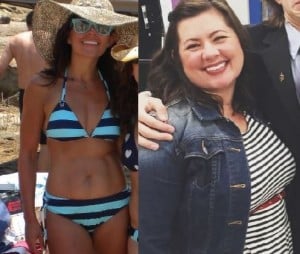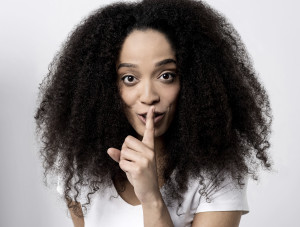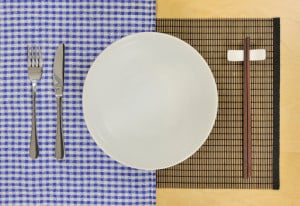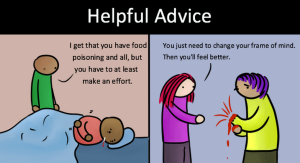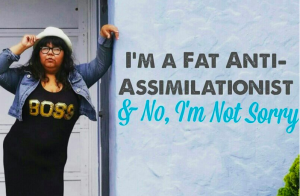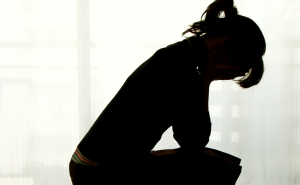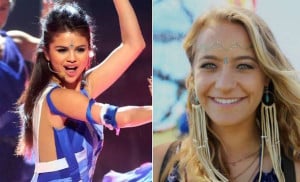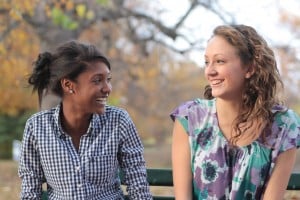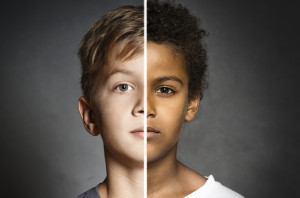Originally published on Beauty Redefined and cross-posted here with permission.
The latest trend in image alteration might surprise a few people who are familiar with the power and pervasiveness of the thin ideal.
Known as “reverse retouching,” this new trend has editors now adding curves and inches in specific areas of women’s bodies to create more voluptuous figures.
But we’re here to tell you there’s nothing “reverse” about this retouching.
It’s more of the same old crap. More carefully chosen young women’s bodies that STILL aren’t quite beautiful, appealing or sexy enough for marketers.
More illusions that cumulate to form a new standard of normal and attainable for women’s bodies in the public consciousness.
More unnatural and unachievable beauty ideals for real-life girls and women to fall short of.
Here’s the deal: we’re all for breaking out of the trap of thin ideals being used to sell EVERYTHING from running shoes to fiber supplements.
The endless stream of tall, thin, young, white women’s bodies dominating every type of media, from advertising to all genres of entertainment, has done more harm than doctors can measure.
We live in a culture that prizes female thinness above all else, as a key to attractiveness, health, desirability and success in every way.
That same culture contributes to the epidemic of eating disorders and all forms of disordered eating, where approx. 10 million women are diagnosable as anorexic or bulimic in the U.S., with another 25 million more suffering with a binge eating disorder (NEDA, 2010).
That culture of appearance obsession that centers on thinness also contributes to the fact that the majority of women in the U.S. claim to be “disgusted” by their bodies, and where 60 percent of girls believe they’d be happier if they were thinner.
That exact same body shame is a major contributor to chronic health issues like cardiovascular disease and diabetes, since one of the major reasons women avoid exercise is fear of being looked at or fear of looking fat.
We’re so over the tyranny of the thin ideal.
So is Photoshopping to add “curves” a step in the right direction?
Absolutely, undoubtedly, without question, NO. Here’s why.
Yes, editors, producers and advertisers are taking images of very thin girls and women and manipulating them in post-production to add size.
But the inches they’re adding are not real. They are not natural. They are stategically, meticulously placed to create idealized hourglass figures on otherwise small, thin frames.
What’s the difference between computer-generated “curves” and real-life “curves?”
Well, for starters: realistic body proportions, including breast shape and bum size in relation to waist size, etc., cellulite, stretch marks, and everything else that reality brings to the table for a curvaceous (or even thin, average, or bodacious) female body.

Keira Knightley in “King Arthur” advertising.
Sure, it may very well be humanly possible to have centerfold-esque measurements and looks without the aforementioned “flaws” of the overwhelming majority of female bodies, but those aren’t the bodies being flaunted in mass media.
Instead, we are seeing thin bodies that are being secretly altered to look voluptuous.
We’re seeing thin, athletic, small bodies like Keira Knightley’s being photoshopped to carry D-cups (see “King Arthur” movie promotional materials, among many others).
We’re seeing Lady Gaga, who openly acknowledges her constant battle for thinness the industry demands, being manipulated to embody a more voluptuous shape (see the Aug. 2012 Vogue cover, with cinched waist and prominent chest and hips).
We’re seeing the signs of anorexia, bulimia and malnutrition being swiftly and secretly airbrushed out of existence to reveal still ideally thin bodies, but plumper cheeks, fewer visible bones in chests, shoulders and hips, and radiant skin.
The lies behind expanding curvaceous ideals are just as sinister as the lies that shrink bodies to unreal thin ideals.
The Daily Mail (one of our least favorite sources) reported that Robin Derrick, creative director of Vogue, admitted: “I spent the first ten years of my career making girls look thinner, and the last ten making them look larger.”
Former Cosmo editor Leah Hardy claimed the same trend in her work, citing Self magazine’s acknowledgement of the same protocol for retouching away signs of “too skinny” and making models “look healthier” (NOT our words).
Tall, thin stars like Cameron Diaz and Taylor Swift are reported to have undergone breast augmentation surgeries in recent months. If those reports are true, they represent just one example the real-life embodiment of photoshopping ideals.
When the digital world of faces and bodies shows an endless stream of thin-yet-curvaceous images of women, it is absolutely no wonder that women are turning to cosmetic surgery to achieve the same ideals.
We call this process physically Photoshopping ourselves out of reality.
Thinness is not the problem here. Hourglass figures or “curves in all the right places” are not the problem here.
The problem here is that the grass is always greener on the other side, and so many industries have capitalized on convincing and re-convincing women (and men) of that lie.
First, thinness is the best, healthiest and most attractive, but those industries aren’t showng us ribs, hip bones, small chests and other naturally occuring effects of thinness on bodies — especially the more unsightly effects of thinness brought on by disordered eating, like gaunt faces and decaying teeth.
Then being “curvy” is the best, healthiest and most attractive, but only with an extremely thin waist, round, lifted breasts, and no cellulite, stretch marks, full arms or flat bottoms.
Heaven help us if a double chin shows up.
Plenty of media is capitalizing on this idea by pinning “real,” curvy women against “skinny” women.
Ripped from the MSN Living headlines Aug. 30, 2012: “Fashion Mag Says No to Skinnies.” Here’s a hint of the terribleness of the whole piece:
“There’s been a trend lately towards real women with curves and away from skinny Minnie models that look unhealthy—and this trend is continuing to take the fashion and media world by storm.”
1) All women are “real.” A particular body type or shape or size does not make someone “real.” The thing that takes their bodies from “real” to “fake” is Photoshop.
2) You can’t determine a person’s health from their appearance. Calling a thin woman unhealthy is just as bad as calling a “curvaceous” woman unhealthy.
3) This “trend” is only taking the fashion and media worlds “by storm” because it is making those same industries big money — not doing any favors for the health and well-being of their audiences and consumers.
For a couple decades they’ve sold us the idea that thinness is the key to health, happiness, sexiness and success, and now they’re capitalizing on the mounting backlash against unattainable thin ideals by pitting one idealized body type against another equally idealized and unattainable body type.
Studies show this “grass is greener” effect is all too real. One of our favorite renowned media scholars, Kristen Harrison (2006), found that for larger girls, TV exposure significantly influenced their belief that their peers thought they should be smaller.
For the smaller girls, TV exposure significantly influenced the belief that their classmates expected them to be larger.
Interestingly, Harrison found the same result three years earlier when she found white women’s exposure to TV beauty ideals predicted the large-busted women wanted smaller chests and small-busted women wanted larger chests.
Basically, that means for-profit beauty ideals in media are WORKING. Too many industries thrive off women feeling bad about themselves and seeking ways to fix their “flaws,” which women naturally perceive as a result of not measuring up to media standards for beautiful or even “average.”
These studies (along with plenty of others) show us that pretty much everyone feels bad. Too fat, too thin, too busty, not busty enough, too tall, too white, too dark — it’s a sure-fire recipe for raking in the $$$.
But not without our cooperation.
Here’s the plan: Let’s stop buying into this baloney.
- Let’s stop enforcing those thin vs. curvy ideals on ourselves.
- Let’s stop enforcing them on our friends, families, strangers and celebrities.
- Let’s recognize how often and how dramatically we’re being duped with non-stop images of skinny-yet-busty-and-bootylicious bodies.
- Let’s re-recognize it all the time by looking critically at all types of media all the time, and then let’s reject those lies.
- Let’s release the power those lies have over our perceptions of our bodies, beauty, health and happiness.
- Rather than dwelling on the seeming downfalls of our own real-and-maybe-not-ideal figures, go for a walk around the park with a friend.
- Go visit someone who could use a chat or a hug.
- Use your flawed body for good, and own it.
Michelle from Australia has been hospitalized for anorexia and is working to regain her health and positive body image. She is without a doubt Beauty Redefined.
Can you imagine the powerful effect of masses of thin, curvaceous, and everything-in-between-and-beyond women forfeiting their body shame and anxieties and spending their money on education or charity or starting their own business instead of a breast augmentation or cellulite treatment or dangerous diet pills?
And those same beautiful women owning their beautiful realities as an example to all their daughters, students and peers who desperately need to see a beautiful reality being embraced instead of hidden, apologized-for or physically photoshopped out of reality?
We can.
Yes, it’s easier said than done, but we can help!
It’s a step-by-step process that differs for everyone, but these strategies work.
Start small, like intentionally shutting down negative thoughts about your own body and others, and then work up to a media fast, setting a serious fitness goal to focus on how your body works instead of how it looks, or start advocating for positive body image among your own family, friends and community.
These and many other totally do-able strategies are outlined here. Instead of internalizing all the Photoshopping phoniness that is only going to get worse, look around you to see how beautiful reality can be.
Curvy, skinny, dark, light, tall, short, able-bodied and differently abled, whatever you’re bringing to the table. The world needs your beautiful reality!
Lindsay and Lexie Kite, 26-year-old identical twin sisters and doctoral candidates in Communication at the University of Utah, founded The Beauty Redefined Foundation in 2009 based on their master’s and Ph.D. research. They have a passion for helping women recognize and reject harmful messages about their bodies and what beauty means and looks like. Lindsay and Lexie have been featured on Al Jazeera English TV, the Huffington Post, iVillage, KSL’s Studio 5, Fox13 News, KUTV2 News, the Deseret News, the Salt Lake Tribune, and many more. Follow on Twitter @TakeBackBeauty.
Search our 3000+ articles!
Read our articles about:
Our online racial justice training
Used by hundreds of universities, non-profits, and businesses.
Click to learn more








